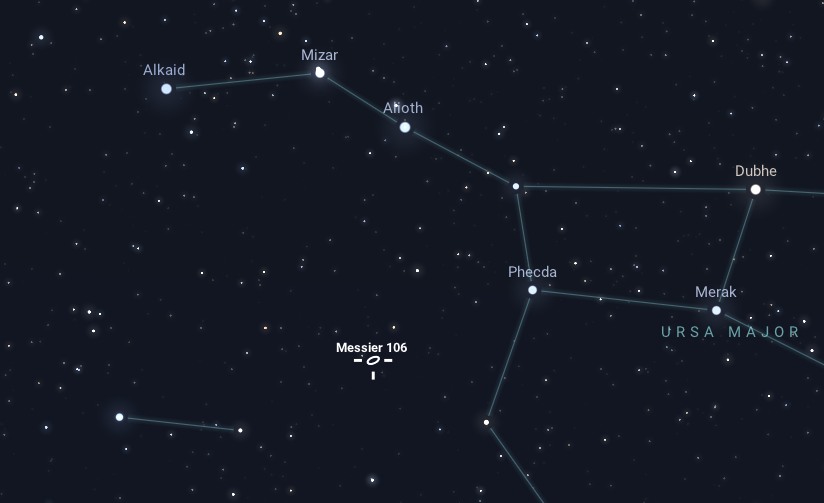M106, also known as Messier 106 or NGC 4258, is a remarkable and intriguing spiral galaxy located in the constellation Canes Venatici. It was discovered by the French astronomer Pierre Méchain in 1781 and later included in Charles Messier’s famous catalog of astronomical objects. It is one of the largest and brightest nearby galaxies, making it a popular target for both amateur and professional astronomers.
Basic Facts
M106 is approximately 22 to 25 million light-years away from Earth, making it relatively close compared to many other galaxies when considered in the context of the vast scale of the universe. This proximity allows astronomers to study its detailed structure and dynamics more effectively than more distant galaxies. With an apparent magnitude of about 9.1, it is visible through small telescopes and even binoculars under good conditions.
Its physical size is equally impressive. With a diameter of about 135,000 light-years, it is larger than our own Milky Way galaxy.
Physical Characteristics
In terms of structure, M106 is a barred spiral galaxy with a distinct central bar and two prominent spiral arms. The spiral arms are populated with young, blue stars and regions of active star formation, often marked by bright HII (ionized hydrogen gas) regions. The galaxy’s disk also contains numerous dark dust lanes and interstellar gas, contributing to its visual complexity. M106’s spiral arms appear to be warped, likely due to gravitational interactions with nearby galaxies.

One of the most notable features of M106 is the anomalous arms, which are visible in radio and X-ray observations but do not align with the visible spiral arms. These anomalous arms are thought to be shock waves or density waves resulting from the interaction of the supermassive black hole’s jets with the surrounding interstellar medium. This phenomenon provides valuable insights into the dynamics of galaxy evolution and the impact of active galactic nuclei on their host galaxies.
Black Hole
One of the most fascinating aspects of M106 is its active galactic nucleus, classified as a Seyfert II. This classification indicates that M106 has an extremely energetic core, likely powered by a supermassive black hole. Observations using various wavelengths, from radio waves to X-rays, reveal that this black hole is actively accreting matter, producing intense radiation and jets of high-energy particles. These jets have been observed extending from the nucleus, interacting with the interstellar medium of the galaxy and causing unusual emission lines in its spectrum.
The galaxy has therefore been a subject of interest for studies involving precise measurements of cosmic distances. It was one of the key galaxies used to refine the distance scale of the universe. By studying the masers—microwave amplification by stimulated emission of radiation—within the galaxy’s active nucleus, astronomers have been able to measure its distance with remarkable accuracy. These measurements have helped calibrate other distance indicators, improving our understanding of the expansion rate of the universe.
Observation
M106 is best observed during the spring months in the Northern Hemisphere, particularly from March to May. During this period, M106 is high in the sky during the night, providing the best views. It reaches its highest point around midnight during its peak season, thus reducing the amount of atmospheric distortion and light pollution affecting the view. Observing from a location with minimal light pollution is crucial for seeing the galaxy clearly. Dark skies enhance contrast and visibility, making it easier to spot faint details. Spend at least 15-20 minutes in the dark to allow your eyes to adjust and become more sensitive to faint light. Avoid looking at bright lights, including phone screens during this time.

M106 is located in the constellation Canes Venatici, near Ursa Major (the Great Bear). Using the Big Dipper’s “bowl” as a guide, you can find Canes Venatici and then locate M106. Start by finding the Big Dipper in Ursa Major. Draw an imaginary line from the star Dubhe (at the top right of the Dipper’s bowl) through Phecda (at the bottom left of the bowl), and extend it outward. This line will point you towards Canes Venatici, where M106 is located.
While M106 can be spotted with good binoculars under dark skies, a small to medium-sized telescope (4-8 inches in aperture) will provide much better views. Larger telescopes will reveal more detail, including its spiral structure and central bar.



